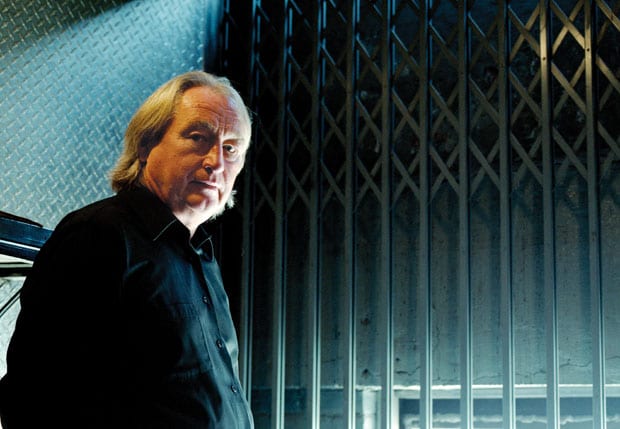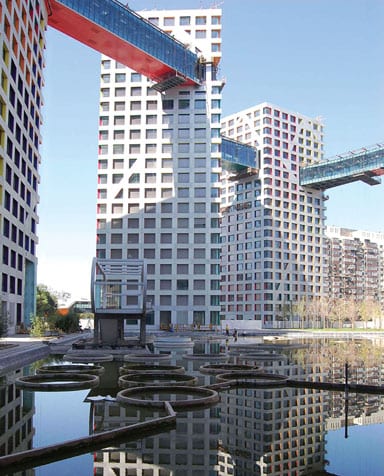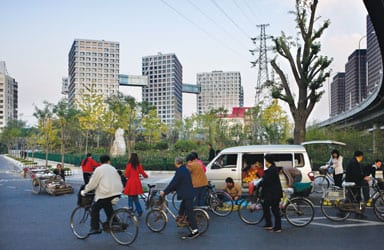
words Justin McGuirk
“I said, Give me three months and I’m going to come back with a vision for the 21st century.” Steven Holl is a writer, teacher, philosophiser, phenomenonologist, watercolourist and one of America’s best architects. But a visionary? This is something of a new stance. Holl is best known as a craftsman who delights in the sensory qualities of buildings, a manipulator of light, form and the reflective qualities of water. Now, suddenly, he is building multiple megastructures and prone to what George Bush Senior called “the vision thing”.
Holl is telling the story of his latest project, a monumental building in Beijing. The word “building” is somehow inadequate to describe eight 22-storey towers connected in the air by a sequence of bridges. He refers to it alternately as “a piece of the city” and “a city within the city”. It is the built manifestation of ideas Holl was first playing with two decades ago, back when, by his own admission, he hadn’t built much more than “a little wooden house out in Martha’s Vineyard”. Those were the years of manifestos and utopian proposals – paper architecture. Now there’s a place where architects of a certain stature can take their dreams and build them. It’s called China.
“This is a country of enormous ambition, which I have to respect,” says Holl. “I never imagined I would have encountered in my life this kind of ambition to build. And when they get going they’re unstoppable.” Holl is sitting in front of a giant computer monitor in an office that overlooks the rail yards and the Hudson River from the 11th floor of a building on West 31st Street, Manhattan. Most days the screen is a Skype conferencing window into his Beijing office; today, he’s using it to zoom through a slideshow of his new work. Under a mop of shoulder-length silver hair his face is flush, either with excitement or the excesses of a bon vivant. He certainly seems galvanised.
Compared to his peer group, a circle made up of Thom Mayne, Zaha Hadid and Wolf Prix, Holl has been slow to build an international reputation. “I was always working against the trend,” he says, “when postmodernism was the thing, when deconstruction came.” As well as perennially out of fashion, he has been stylistically inconsistent as a matter of principle. “Consistency is the hobgoblin of little minds,” he adds, quoting philosopher Ralph Waldo Emerson.
Now, though, Holl has entered a new phase of his career, the one that will come to define him. It started with his sophisticated art building for the University of Iowa in 2006, and took off with his luminous extension to the Nelson-Atkins Museum in Kansas last year, which is one of the most critically acclaimed American buildings in a generation. Alongside what he’s calling the Linked Hybrid, in Beijing, he is also building two other monumental projects in China: a vast corporate headquarters in Shenzhen that could be a homage to radical Sixties group Superstudio, and a massive housing development in Chengdu. The question is, can this craftsman and theorist, who repeatedly refers to himself humbly as “a teacher”, step up to the urban scale and deliver the visionary architecture he’s promising?
One thing in his favour is that Holl has a talent for turning a project into what he wants it to be, rather than what his clients ask for. He won the competition for the Nelson-Atkins Museum by flouting the restrictions imposed on the site. In Beijing, he was asked to convert “a very bad old factory building” into a museum, but persuaded his client to build the Linked Hybrid: a 220,000sq m mixed-use complex with housing, schools, a hotel, a cinema, swimming pools and roof gardens. “All those things I added,” says Holl. “You know, it’s almost as if you were running a studio – I teach at Columbia – and you asked the students to make an ideal project out of something that wasn’t ideal, and they built it.”
Of course, building the ideal student project might not be a good idea. Post-war Europe was littered with architects’ visions of social utopia that didn’t go according to plan. Is this one different? Is China different?
Holl’s grand idea is “that the 21st century city can be as sectionally and horizontally connected as it is vertical.” The eight towers of Linked Hybrid stand in a ring connected by skybridges that contain public amenities – in one there’s a swimming pool, in another an auditorium. There are nearly 800 apartments, whose value has allegedly quadrupled since they went on the market. The complex also boasts impressive green credentials, with heating drawn from 660 geothermal wells and the grey water recycled into a vast reflective pool. Holl wanted to create a place where residents would have everything they need, “almost like Greenwich Village”, but he is also at pains to point out how much Linked Hybrid is a porous public space. He says he took the developers around Rockefeller Center to illustrate how private land can be opened up to all. “That’s my prime driving force,” he says, “to try to take these unwieldy capital programmes and make pieces of cities that have some gift to give to the future, regardless of who occupies the apartments above.”
The roots of Linked Hybrid lie in a series of projects Holl designed in the wilderness years of the late 1980s, published in a book called Edge of a City. Essentially, they were attempts to intensify the metropolitan landscape and counter urban sprawl. One of them, called Parallax Skyscrapers, is a series of towers linked by skybridges. “These were visionary projects,” says Holl. “And the thing that’s really exciting is that 18 years later there would be the kind of ground that someone could start thinking in quasi-utopian ways. So I’m occupying a moment in time I never foresaw.” Interestingly, the typology Holl was developing in Edge of a City has had one previous chance of becoming real: he proposed a rationalised version for the World Trade Center in 2002 along with Peter Eisenman, Richard Meier and Charles Gwathmey. Of course, it remained a dream.
Nowadays, China is the testing ground for the heroic super-modernism of the 1970s, and the quest to add a horizontal dimension to the skyscraper has moved to Beijing. There is a similar rhetoric behind OMA’s looped CCTV headquarters a few miles to the south. Both buildings claim to hark back to the horizontality of pre-boom Beijing, when building higher than the Forbidden City was, well, forbidden. Yet it’s hard to avoid the feeling that OMA’s is the more radical proposal. It may not have been possible for Holl to build Linked Hybrid before now, but the building’s conceptual premise hasn’t advanced much since the Eighties. It looks strangely dated.
Only in China, which missed out on the West’s modernist housing experiments of the mid-century, could it be called new. Otherwise it is the Beijing equivalent of London’s Barbican, with higher bridges, or Holl’s dormitory building at the Massachusetts Institute of Technology, with bridges. Either way, it’s a language we can trace back to Fritz Lang’s Metropolis. Despite the admirable ambition to create an urban microcosm, there is still a whiff of the totalitarian about Linked Hybrid. It looks like the perfect setting for a JG Ballard novel in which the social utopia gets tainted by primitive hierarchies and, if Ballard were really going for it, possibly cannibalism.
Holl himself describes it, by turns, with infectious excitement and dreamy abandon. Of the recreational spaces in the public concourse, one, which he calls “a place of reflection”, triggers a characteristically Holl-like meditation: “I was thinking about the notion of infinity, the notion of really infinite space, and I was thinking about the Milky Way galaxy, which is 100,000 light years across and 10,000 light years deep, so, the ratio of one to ten. But then what about all the other galaxies? They say over 100 million other galaxies – this notion of infinite, a feeling of infinite.”
Holl has an intellectual disposition. He is a man of polymathic references who is prone to find the inspiration for a design in a quote from Melville or a passage of Bartok. As with Daniel Libeskind, Holl likes to give his projects “conceptual cement”. With the academic’s penchant for naming his ideas, he calls it “anchoring”, and in his recent book, House, he argues that it is the great challenge facing architects today, as they work in increasingly diverse and unfamiliar countries.
Holl’s two other massive schemes in China feel more original than Linked Hybrid, perhaps because they are “anchored” more specifically to their contexts rather than reprised from the utopian back catalogue. Still under construction, one is the headquarters of southern China’s largest housing developer, on the edge of Shenzhen. It’s a long dendritic slab reminiscent of Superstudio’s Continuous Monument, except that it hovers above the ground “like a low-flying plane”. The other, in Chengdu, is a 3 million sq ft mixed-use development that looks like a deconstructivist termite mound. The mountainous arrangement of towers is slashed in diagonals to allow sunlight into the complex. These projects may well prove more influential in the long run.
When I suggest that Holl sounds energised by his Chinese adventure, he points out that it hasn’t all been plain sailing. The final project he shows me, a little museum in Nanjing, has been under construction for the last six years. It’s a lovely building made of concrete that has been shuttered with bamboo – a surprisingly rare, or perhaps totally original, technique. That unexpected touch is vintage Holl, and it is almost poignant to be reminded of this craftsman’s delicate skills after an hour of receiving his grand visions. It’s too early to say whether the Chinese megastructures will finally turn the teacher into the starchitect, but he appears to have joined that small group of architects in the waiting room for a Pritzker Prize.
Portrait by Anna Schori




















